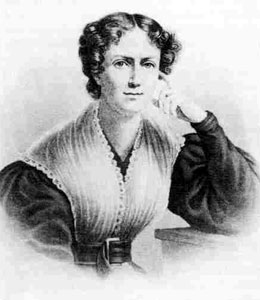
Frances Wright
Frances Wright was arguably the most radical utopian thinker and activist in antebellum America. She advocated the freedom and equality of women, African American slaves, and white working people and designed social experiments to bring the United States closer to what she considered its fundamental principles. In Tennessee she launched a memorable attempt to find a peaceful solution to the problem of slavery through the education of slaves and the financial compensation of slave masters.
Orphaned at the age of two, Wright received a liberal education from her uncle, James Mylne, a professor of moral philosophy at the University of Glasgow, a center of the Scottish Enlightenment. Secure in the belief that all people might be educated to liberty and excited by the idea of revolutionary America and the sentiments of the Declaration of Independence, Wright first visited the United States in 1818. Her glowing account of the new nation, Views of Society and Manners in America, brought her to the attention of the Utilitarian philosopher James Bentham and the American hero General LaFayette and fixed a place for her in the circles of the leading European intellectuals.
In 1823 Wright accompanied LaFayette to the United States, where she visited a number of communitarian experiments and entered an association with Robert Dale Owen and the New Harmony Community. Wright adopted the notions of cooperative labor and universal education expressed by these utopian endeavors as the means to the abolition of slavery.
In 1825, on the recommendation of Andrew Jackson, Wright purchased a tract of land outside the village of Memphis. She acquired fifteen slaves and, accompanied by her devoted younger sister Camilla and a few like-minded friends, established the biracial community of Nashoba. Wright hoped to obtain support from white slave owners for the community in which slaves would labor in the fields to repay their purchase price, while receiving education for liberty for themselves and their children. As a necessary compromise, Wright agreed that when slaves were freed, they would be colonized outside the United States.
The brief Nashoba experiment came to an end when Wright left the community to recover from bouts of fever and enlist support. In her absence, one of the trustees published an account of Nashoba’s daily workings that offended supporters and critics. James Richardson reported the flogging of slaves, parental dissatisfaction over the loss of control over the lives of their children, sexual misconduct, and miscegenation. The experiment lost the little support it had and ended within four years, in 1829, with Wright personally escorting the remaining slaves to Haiti, where she had secured guarantees of their freedom and livelihood.
Following the collapse of Nashoba, Wright intensified her role as social critic and reformer. With Robert Dale Owen, she edited and wrote for the Free Enquirer, the New Harmony newspaper. She and Owen founded the Working Men’s Party in New York, and Wright pioneered a day school for workers’ children and a dispensary for working people. On the lecture circuit, Wright presented a vision of an egalitarian nation made possible through a national system of education that would place all children above two years old in boarding schools free of religious instruction. She argued for the liberation of women from unjust marriages and their exclusive roles as wives and mothers and advocated economic independence and education for women to enable them to take their places as free citizens. During a period of religious revivalism, Wright proposed a rational world, free of religious superstition and clerical power. “Fanny Wrightism” became a synonym for infidelity and radicalism, especially when, in the late 1830s, she became a partisan of the locofoco, or left wing of the Democratic Party.
Suggested Reading
John Egerton, Visions of Utopia: Nashoba, Rugby, Ruskin, and the “New Communities” in Tennessees Past (1977); William H. Pease and Jane H. Pease, “A New View of Nashoba,” Tennessee Historical Quarterly 19 (1960): 99-109; Sheree Sampson, “Reclaiming a Historic Landscape: Frances Wrights Nashoba Plantation in Germantown, Tennessee,” Tennessee Historical Quarterly 59 (Winter 2000): 290-303



